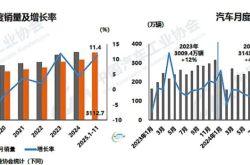Dell: Can the Legacy PC Giant Rejuvenate with the Rise of AI?
![]() 07/11 2025
07/11 2025
![]() 506
506
As consumers, we are most familiar with Dell's laptops. Beyond computers, Dell's servers are also a cornerstone of the company's product portfolio. With the surging demand for AI, AI servers and AI PCs have elevated market expectations for Dell.
From a historical perspective, many brands in the PC market have faded away, while Dell's revenue has consistently increased over the past three decades. This is primarily attributed to Dell's adeptness in capitalizing on the waves of technological advancements in PCs, servers, and network equipment. Currently, Dell's annual revenue stands at nearly $100 billion.
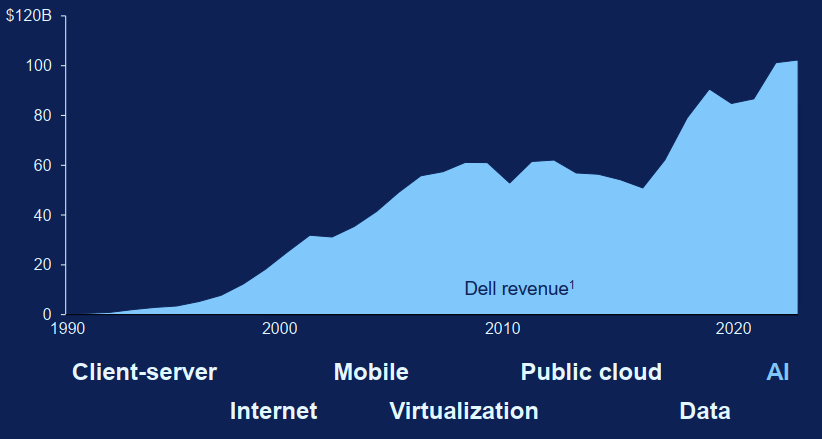
Building on its expertise in PCs and servers, Dell has entered the forefront of this AI revolution. Driven by increased investments in AI clouds and the potential of AI PCs, the market anticipates Dell to achieve even greater heights. In this article, Dolphin will objectively discuss the potential opportunities and risks for Dell, the seasoned PC giant, amidst this wave.
This article primarily focuses on the following questions:
1) Despite fierce competition in the PC market, why has Dell continued to grow?
2) Is Dell competitive in the server market?
3) What is the potential in transitioning from PCs to AI PCs?
4) With the support of AI servers and AI PCs, what investment value does Dell possess?
Here are the details:
I. What Kind of Company is Dell?
Much like the well-known Dell computers, the company indeed began as a computer manufacturer. After the chaotic brand wars of the 1980s, the PC market landscape solidified in the 1990s, with the top 9 vendors accounting for over half of the market share. At that time, Compaq led the pack, while Dell was still a contender. However, the two companies subsequently embarked on vastly different development paths.
After 2000, Dell expanded from PCs into servers, storage devices, and other markets, gradually transforming from a single PC vendor to a full-stack IT service provider. In contrast, Compaq, which remained focused on the PC market, eventually exited and was acquired by HP.
Dell's development has primarily gone through four crucial stages: direct sales model -> Internet empowerment -> crisis period -> reinvention as an IT full-stack service provider.
a) Startup Stage (1984-1990): Direct Sales Model, Reducing Operating Costs
Dell initially adopted a "direct sales model," bypassing intermediaries and manufacturing computers according to customer requirements for direct shipment. This model directly challenged the traditional "manufacturer-distributor-retailer" model represented by Compaq and IBM at that time. Moreover, against the backdrop of the industry commonly using high inventory distribution, Dell pioneered "build-to-order" (BTO), which gave the company a significant supply chain advantage and enabled it to gain a strong foothold in the PC market.
① Cost Advantage: Eliminating distribution links saved 15%-20% in channel costs, with computer prices 20% lower for the same configuration;
② Response Speed: Production and delivery were completed within 72 hours after customer orders, compared to 2-3 weeks for the traditional model.
b) Expansion Period (1991-2004): Internet Empowerment and Efficiency Leap
In the 1990s, although Dell was among the top five in the PC market, it was still a contender. However, the company seized the opportunity of the Internet's development. In 1996, Dell combined its direct sales model with the Internet and launched an e-commerce platform, achieving a significant leap: the company's daily online sales soared from $1 million to $50 million per day by 2000.
Leveraging the layout of global production bases, Dell further shortened the response time. In 2001, Dell became the global leader for the first time, surpassing Compaq.
During this period, Dell leveraged its efficiency advantage of a 4-day inventory cycle (compared to 60 days for Compaq and 45 days for HP) to put Compaq in a desperate situation of "losing money if prices are reduced, losing market share if not".
c) Crisis Period (2005-2013): Multiple Crises, Loss of Market Share
This was a period of crisis for the company, with product issues and the collective resignation of senior executives directly causing a crisis of trust in the market. During this time, the company's market share in PCs fell from first to third, and profits plummeted, ultimately leading to the company's privatization in 2013.
d) Regeneration Period (2013 to Present): Full-Stack Service Provider and New AI Battlefield
After the return of company founder Michael Dell, he drove radical changes and firmly transitioned Dell to a comprehensive enterprise information service provider. In 2016, Dell acquired EMC, a leader in the data storage industry, for $67 billion, forming a closed loop of IT services from terminals to data centers.
After the acquisition, Dell transformed from a declining PC supplier into the world's largest company covering data storage, servers, and clients. As evident from the company's current financial reports, Dell's core business is primarily divided into two parts: Client Solutions Group (CSG) and Infrastructure Solutions Group (ISG):
① Client Solutions Group (CSG): This is Dell's foundational business, accounting for 53%. It primarily sells hardware products and related services to businesses and consumers, including desktops, workstations, laptops, monitors, and peripherals;
② Infrastructure Solutions Group (ISG): This is the key business after the acquisition and integration, accounting for 44%. This part of the business primarily provides full-stack IT service solutions, including servers, network equipment, and storage.
Previously, the company's Client Solutions Group accounted for approximately 60% of the total, but with the increasing demand for AI servers and related areas, the proportion of the Infrastructure Solutions Group business has increased trendwise, and the current proportion of the two core businesses is close to 1:1.

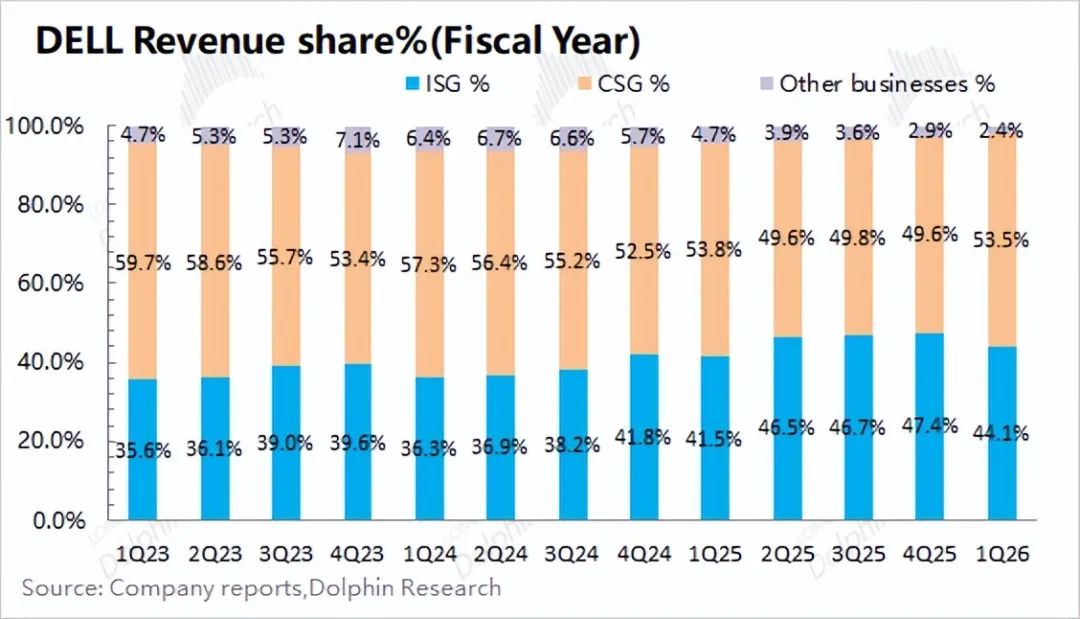
Comprehensively considering the development process, Dell's ability to continue growing without experiencing the exit of companies like Compaq is primarily due to the efficiency improvements brought about by the company's "direct sales and supply chain innovation + direct sales online expansion" as well as the clear strategic positioning of the company's founder. After transforming Dell into an IT full-stack service provider, AI empowerment in this round of changes is expected to usher in a new chapter of growth for the company's server and PC businesses.
II. Key Focus: How Competitive is Dell's Server Business?
While laptops and other products remain Dell's core business, the company's server business is currently the most closely watched by the market. The company typically divides its ISG business into server networks and storage, and with the growth of AI servers, Dolphin estimates that Dell's AI servers account for about 20% of the ISG business.
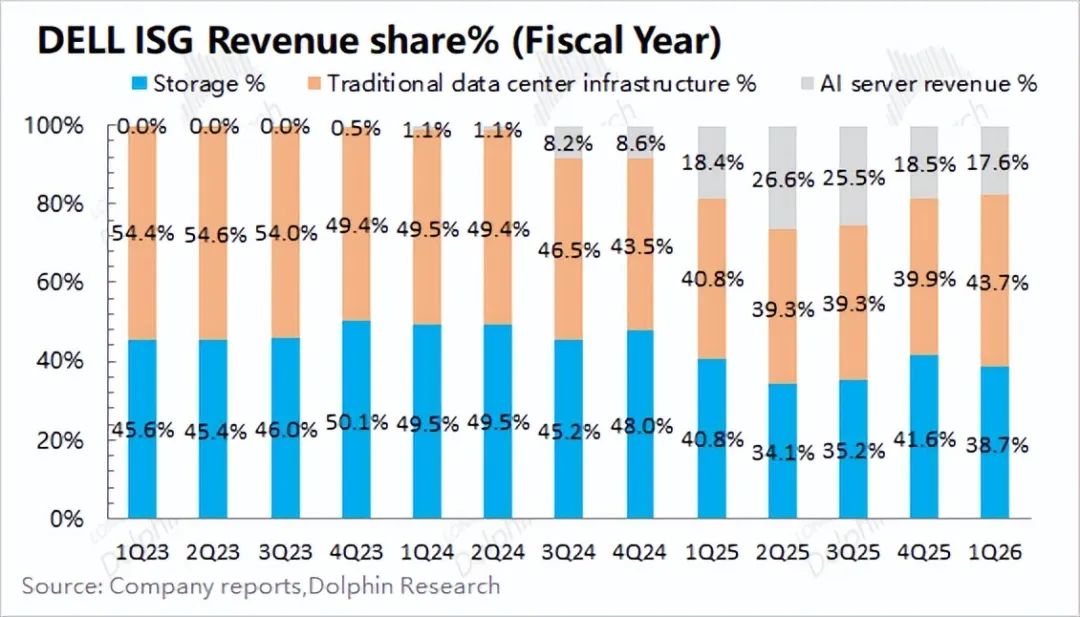
How is Dell's server business progressing? Dolphin primarily looks at it from three perspectives: the industrial chain, market situation, and competitive relationship.
2.1 Server Industrial Chain
The AI server industrial chain spans upstream (core components such as GPUs, CPUs, and storage chips) -> midstream (AI server vendors) -> downstream (cloud service providers, enterprise customers, government customers, etc.).
Dell's server business is primarily located in the midstream of the industrial chain, responsible for designing, assembling, and testing server systems. In other words, the company designs and assembles various components such as NVIDIA and AMD GPUs, CPUs, etc., into servers and then ships them to downstream cloud service providers such as AWS and Google.

Since the company faces different customer groups downstream, Dell plays two distinct roles: "contract manufacturer" and "hardware integrator":
1) Facing small and medium-sized enterprise customers: Dell plays the role of "hardware integrator + solution provider," primarily offering standardized server products. Dell can fully choose core devices such as NVIDIA or AMD, and customers can only select models from the products provided by Dell;
2) Facing large cloud service providers: The company is more akin to a "contract manufacturer + service provider". Due to the relative strength of large customers and their relatively clear customization needs, Dell primarily focuses on hardware integration and manufacturing. Simultaneously, due to the large purchase quantities, large customers have greater bargaining power, resulting in relatively thin profits on the company's hardware side;
3) Facing government and related customers: Between small and medium-sized enterprises and large cloud service providers, this type of customer has partial specified needs, and the company primarily provides localized services with moderately profitable margins.

From the perspective of the server industrial chain, upstream faces core suppliers such as NVIDIA and AMD, while downstream includes customers such as large cloud service providers like Amazon, and the company's midstream bargaining power is relatively limited. Compared to NVIDIA's operating profit margin of up to 60%, Dell's profitability is significantly weaker, with the overall operating profit margin of its Infrastructure Solutions Group (ISG) business, including servers, maintained within the 10-20% range.
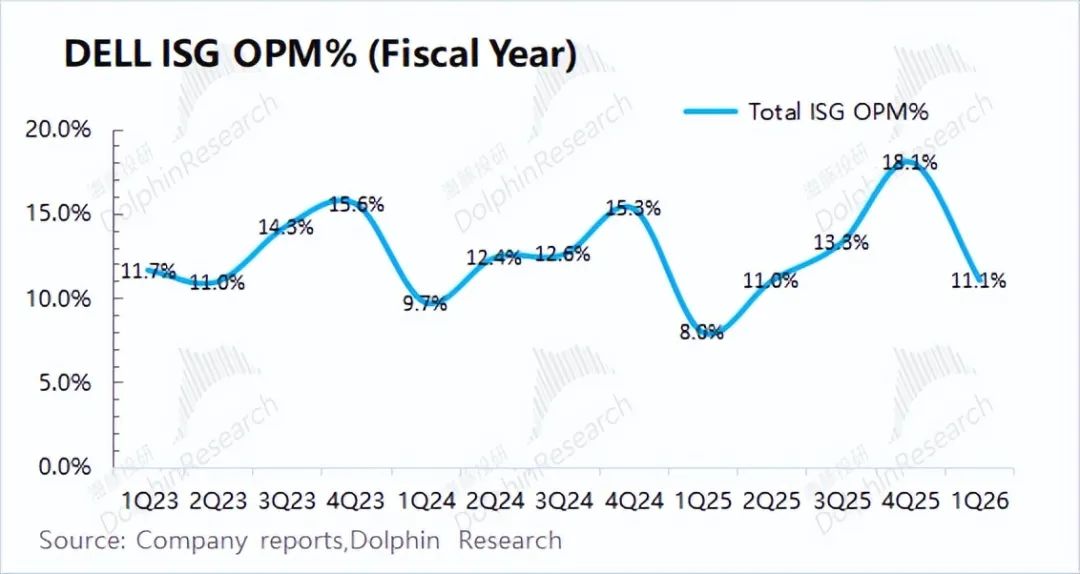
2.2 Dell's Market Position
What position does Dell hold in the server market? From the current server market share, it is primarily divided into ODM vendors and brand vendors, accounting for 47.3% and 29% of the market share, respectively. Although Dell ranks first among brand vendors, it only holds a 7.2% market share, with ODM vendors still being the most preferred by downstream customers.
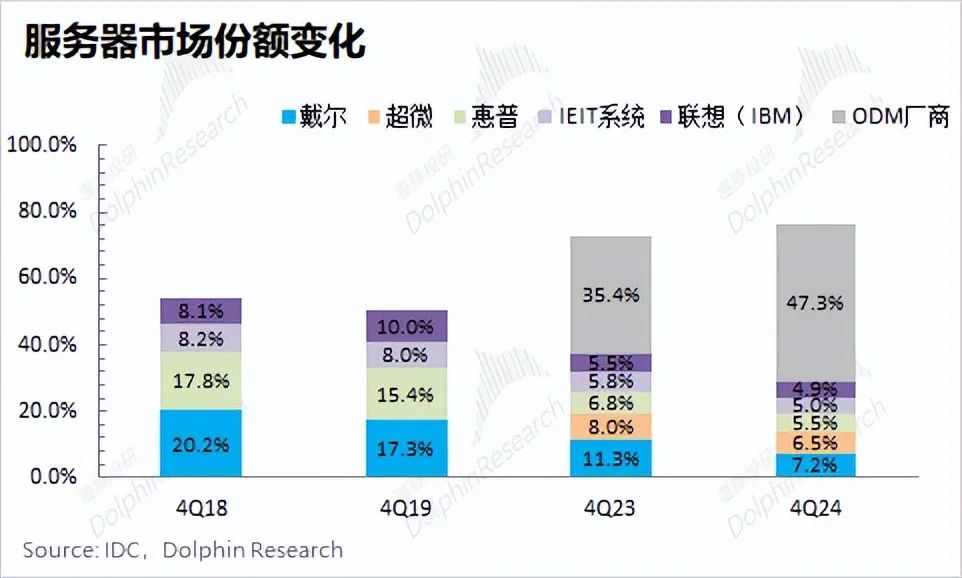
What do ODM vendors primarily do, and why have they become the most preferred in the market? Here, we can first understand the specific delivery levels of servers, which can be primarily divided into 12 major delivery levels.
Specifically: L1-L10 primarily focus on server system manufacturing, which can also be directly delivered; while L11-L12 include cables, racks, and later operations and maintenance, etc.
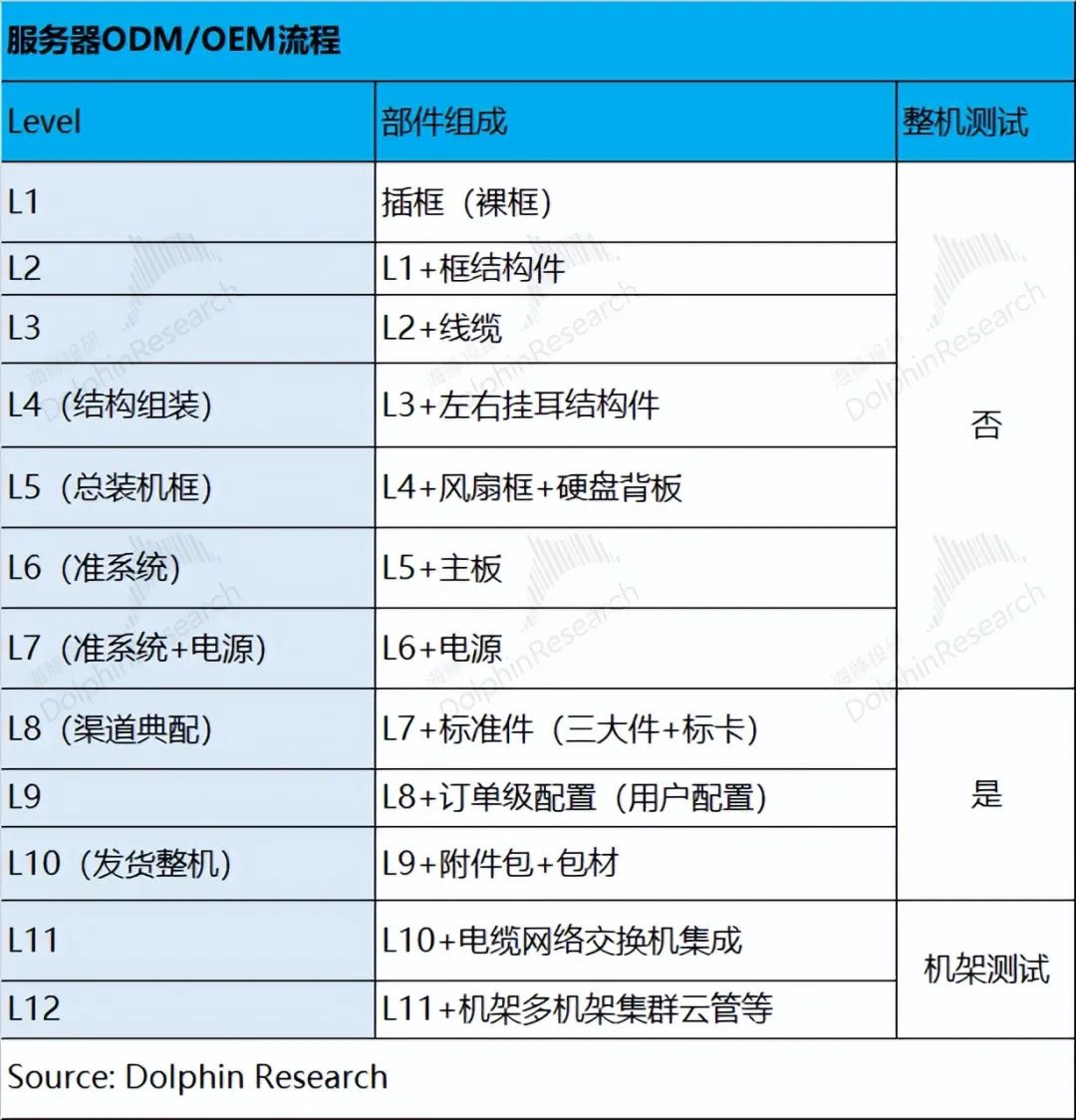
Comparing ODM vendors and brand vendors in server manufacturing and delivery, we can find:
a) ODM vendors (such as Foxconn, Quanta, etc.): Primarily play the role of contract manufacturers, focusing on hardware manufacturing (covering L1-L10). After completing L10, they ship the complete system for delivery;
b) Brand vendors (such as Dell, HP, etc.): As brand vendors, they provide full-stack solutions (covering the entire L1-L12 range). On top of ODM hardware manufacturing, they also add content such as cable network switches and multi-rack clusters, and also provide subsequent operations and maintenance services.
Combining (a+b), it can be seen that Dell and other brand vendors undertake more tasks than ODM vendors, so the gross margins of brand vendors are also significantly higher than those of ODM vendors. Currently, the server gross margins of Dell and HP reach 20-30%, while the gross margins of contract manufacturers such as Foxconn are only around 6%. Therefore, Dell sometimes outsources some orders, allowing it to earn the difference in gross margins.
In this scenario, large cloud service providers may think: "Our company has staff for operations and maintenance, existing contract manufacturers are available, and demand is high, so why pay more to middlemen like Dell?" Therefore, large cloud service providers have decided to eliminate "middlemen" and directly place orders with ODM vendors. Since large cloud service providers are the primary buyers in the server market, this has led to ODM vendors accounting for approximately half of the total market share.
Moreover, as Google, Amazon, and other vendors increase their investment in custom ASICs, they will rely more on ODM vendors in the future. While ODM vendors provide hardware integration and manufacturing capabilities (L1-L10), Broadcom and Marvell will form a good complement in networking, high-speed interconnect, and other aspects (L11+), and large cloud service providers will further move towards the ODM Direct model.
Although brand vendors such as Dell and HP have obvious advantages in technology, operations and maintenance, and response, the price advantage of ODM vendors directly influences the decision-making of large cloud service providers.
Therefore, Dell currently has a relatively small share among leading cloud service providers, and the company's core customers are primarily second-tier cloud service providers, including Tesla, Oracle, CoreWeave, Lambda Labs, etc.
Under the current situation of significantly increased capital expenditures by leading cloud service providers, Dell's benefit is not as obvious as that of ODM vendors. For Dell, the primary driving force for server business growth stems from second-tier and emerging cloud service providers and other government and enterprise customers.
2.3 Dell Server Product Performance and Target Customers
Due to the customized needs and relatively complete teams of large cloud service providers, ODM manufacturers have a more pronounced price advantage when significant capital expenditures are invested. Dell, leveraging its deep cooperation with NVIDIA and a comprehensive operations and maintenance system, is primarily favored by customers in the enterprise and government sectors. So, how competitive are Dell's server products in the market?
We will delve into the core performance comparisons of server products from various companies:
a) GPU Density: Dell surpasses Supermicro, which in turn outperforms ODM Manufacturers and HP HPE (offering 8 GPUs per node, necessitating multi-node stacking).
b) Networking: Both Dell and Supermicro support 400G InfiniBand, whereas ODM manufacturers specialize in customized high-speed interconnects.
c) Liquid Cooling Maturity: Dell and Supermicro lead, followed by HP, with ODM Manufacturers trailing behind.
d) Operation and Maintenance Response: Dell and HP excel, followed by Supermicro, with ODM Manufacturers coming in last.
e) Price for Same Configuration: Dell and HP are priced higher than Supermicro, which in turn is priced higher than ODM Manufacturers.
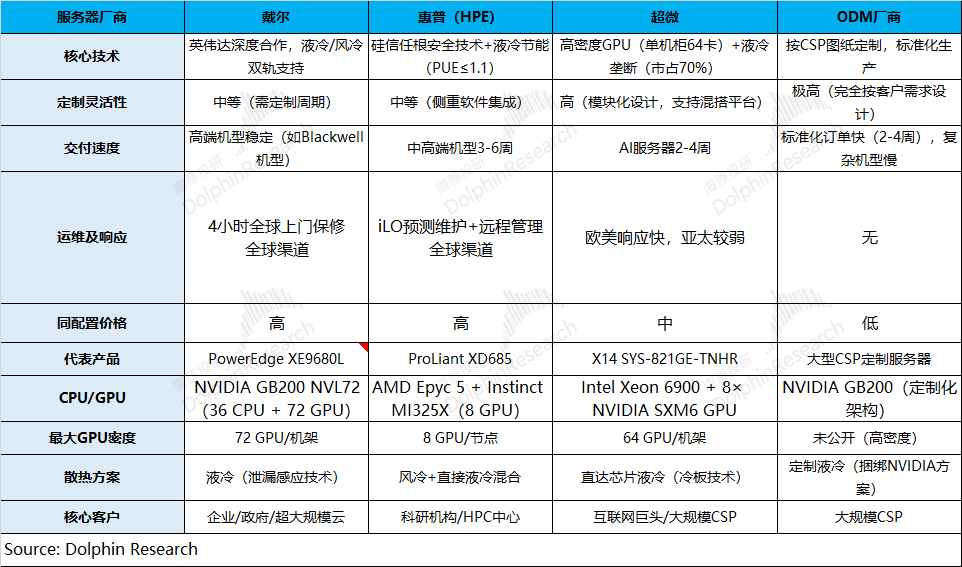
Dell's performance, configuration, operation, and maintenance stand out, resulting in higher prices compared to competitors with similar configurations. Analyzing gross profit margins, Dell and HP maintain around 20-30%, Supermicro around 10%, and ODM manufacturers generally at 5-6%.
Based on this data, Dolphin Insights has crafted a decision tree flowchart for server demand (shown below):
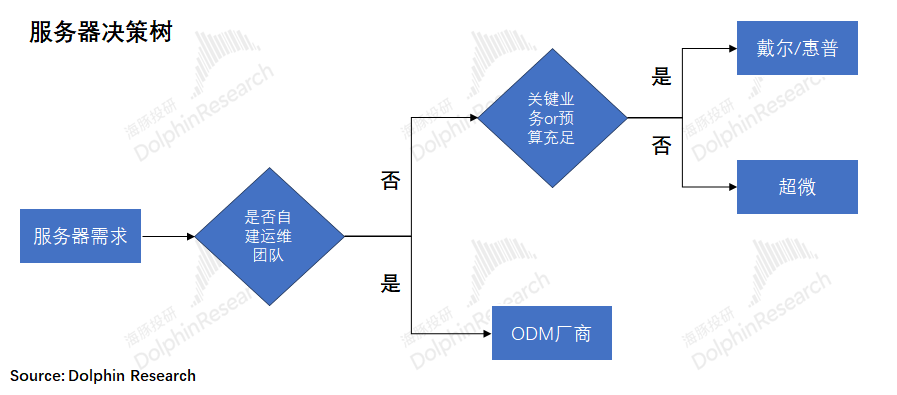
Specifically, each company's server products cater to distinct customer groups:
① Dell Servers: Ideal for critical sectors like finance, healthcare, and government, where reliability commands a premium.
② HP Servers: Suited for education, government, and other settings, offering cost savings on electricity bills through liquid cooling.
③ Supermicro Servers: Best for AI training clusters prioritizing configuration and cost-effectiveness, tolerating lesser operation and maintenance services.
④ ODM Servers: Preferred by large cloud service providers like Google and Amazon, aiming to reduce costs while possessing self-development and self-construction capabilities.
2.4 Server Market Space
Combining market forecasts from IDC and Trend Force, the total server market is anticipated to grow from $306.7 billion in 2024 to $608 billion in 2029, with a compound annual growth rate of 13.5%, primarily fueled by the AI server market.
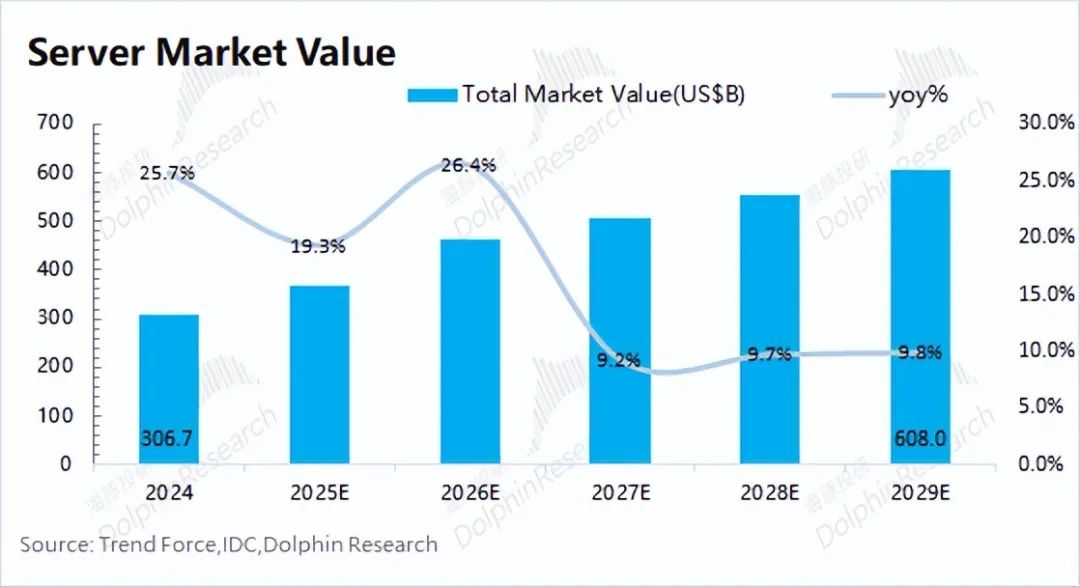
Breaking down the server market by volume and price:
a) Traditional Servers: With stable shipment volumes hovering around 13-14 million units annually, traditional servers account for about 11-13 million units. Assuming an average price of $0.5 million per server, the traditional server market amounts to approximately $55-60 billion, offering limited growth potential.
b) AI Servers:
① Volume: According to Trend Force, the compound annual growth rate of global AI server shipments over the past five years has been 27%, closely mirroring the 27.7% compound annual growth rate of total capital expenditures by the four major cloud service providers. This underscores the pivotal role of large cloud service providers in driving server market growth.
Dolphin Insights anticipates a slight deceleration in AI server shipment growth, maintaining a compound annual growth rate of 15.6% over the next five years. Currently, AI servers represent about 14% of total market volume, expected to rise to 25% by 2029.
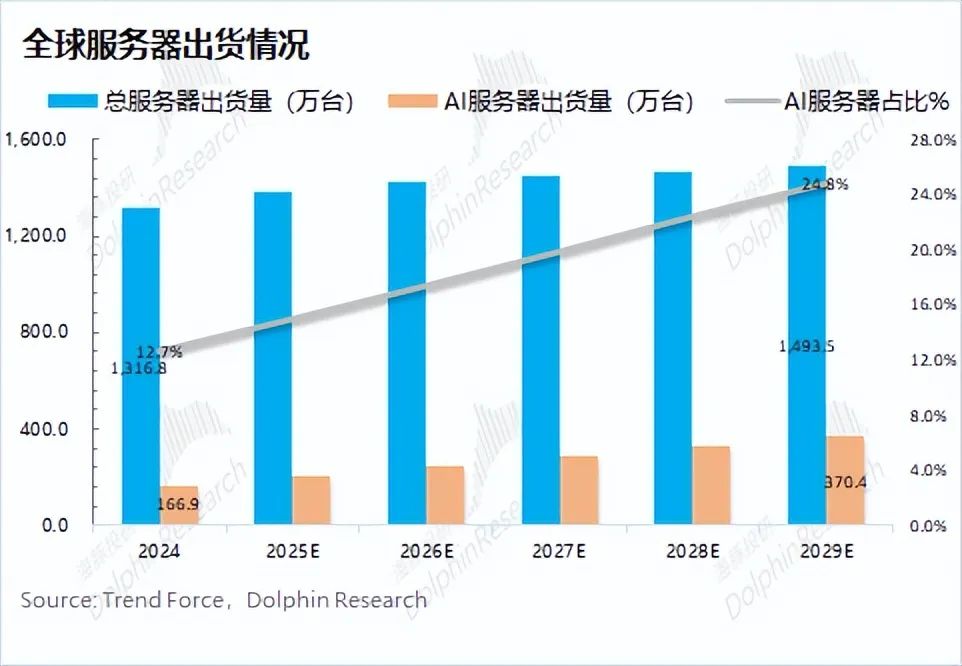
② Price: Market data suggests that the average price of AI servers ranges from $150,000 to $160,000, significantly higher than traditional servers. High-end AI servers can exceed $1 million, elevating the overall average price. With improved server performance and integration, high-end prices are expected to continue rising. Meanwhile, there is ongoing demand for mid-range and low-end AI servers. Dolphin Insights assumes the overall average price of AI servers will remain relatively stable.
③ AI Server Market Space: Considering both volume and price, the AI server market is projected to grow to $551.8 billion by 2029, with a compound annual growth rate of 15.8% from 2025 to 2029.
Combining traditional and AI servers, Dolphin Insights forecasts the overall server market to expand beyond $600 billion, with a compound annual growth rate of 13.5%. The surge in AI server demand has expanded the server market by tenfold, from the previous $50-60 billion (dominated by traditional servers). By 2029, while AI servers will account for only 25% of shipments, they will contribute nearly 90% of the market size.
2.5 AI Servers and Dell's Advantages
Server OEM brands (Dell, HP, Supermicro) entered the AI server market successively after 2022, each with distinct strengths:
a) Dell: Commenced its layout in 2023, fostering deep ties with NVIDIA.
b) HP: Accelerated investments in 2024, establishing collaborations with NVIDIA and AMD but lagging in liquid cooling technology.
c) Supermicro: Pioneered the shift towards AI servers, collaborating with both NVIDIA and AMD and boasting superior liquid cooling technology.

Comparing the flagship AI server products, Dell's offering stands ahead of Supermicro and HP. Leveraging its close partnership with NVIDIA, Dell delivered the PowerEdge XE9712 to CoreWeave, the world's first AI server system based on GB300, positioning Dell as a front-runner in overall progress.
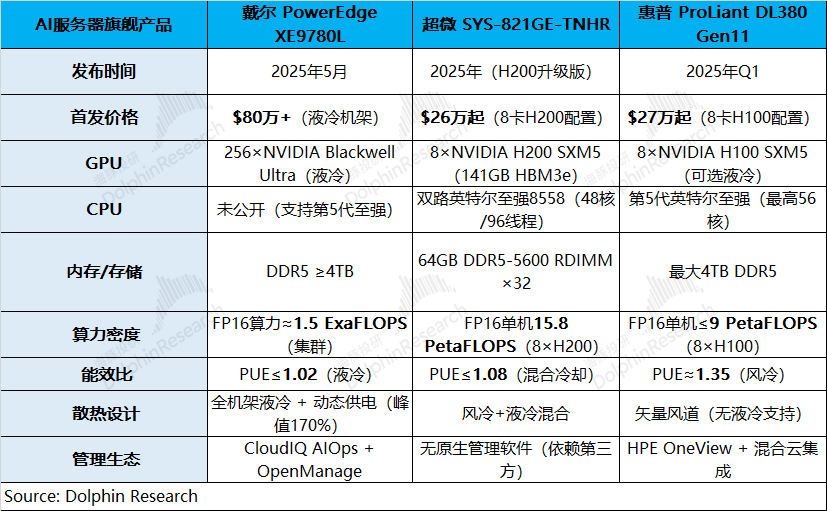
Since Dell's large-scale AI server deployment in 2023, the company's AI server revenue has soared, approaching $10 billion for the full year 2024.
Dell's deep collaboration with NVIDIA in AI servers has impacted the sequential revenue decline over the past two quarters, primarily due to the transition in GB-series chip adjustments.
With GB300 mass production ramping up and driven by demand from second-tier and emerging cloud service providers like CoreWeave, Dell's AI server revenue is poised for rapid growth in the second half of the year, shaping a "front-loaded low, back-loaded high" pattern for the full year.
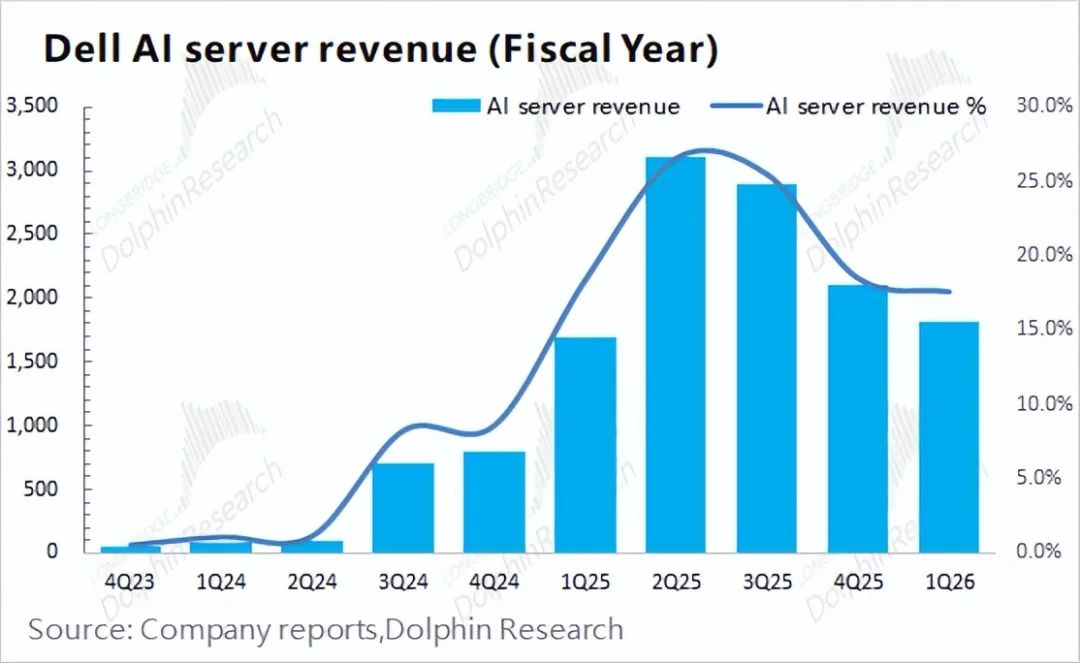
This concludes our analysis of Dell's server business. The next segment will delve into the PC business, particularly opportunities in AI PCs, alongside an overall assessment of the company's value. Stay tuned.
- END -
// Reprint
This article is an original creation by Dolphin Insights. Please seek authorization for reprinting.





